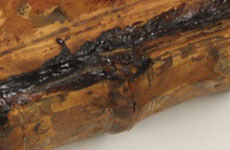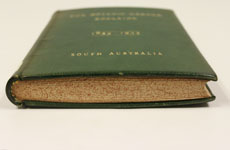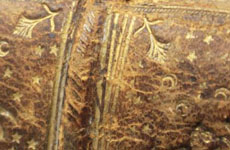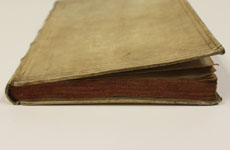When Bindings Go Bad...
Cover to Cover: Exposing the Bookbinder's Ancient Craft
There are many reasons why bindings begin to fail. A small percentage of these can be attributed to poor workmanship and inappropriate choice or quality of materials used during the initial binding process; the vast majority, however, can simply be chalked up to the ravages of time.
Though robust if constructed well, books are not interminable. Their longevity is dependent upon a variety of factors, environmental conditions in particular. Air pollution and extremes and fluctuations in both temperature and humidity can rapidly accelerate the deterioration of glues, paper, cloth and leather. Cloth and paper are also highly susceptible to photolytic damage caused by excessive exposure to light. Insects and rodents, too, are attracted to paper and glues, and will steadily munch their way through a bevy of books given the chance.
These are fairly obvious accelerators though. There’s another worthy of mention here. Less apparent but frequently more insidious, the human being can be rather rough with books. We bend their covers beyond 180 degrees, we crush their spines under copiers and we dog-ear and mark their pages with indelible inks, foodstuffs and beverages. It’s not easy being a book. Many years ago, I worked in a Library to which a patron returned, somewhat sheepishly, a borrowed book. Having accidentally driven over it (whilst open) with their 4x4, its front and back covers found a new “bitumen grain” and its pages, the latest design in rubber tread. Fortunately most damage suffered at the hands of humans is inadvertent. Readers can’t help but frequently handle a popular book, and they really do mean well when they attempt a ‘repair’ which conservators know will only compound the problem; perhaps even create another one. Even binders have embraced new materials and techniques which have later proven catastrophic. Need we mention Caoutchouc? (refer Sewing cabinet) At the time, though, these ideas were innovative, they sped up the binding process considerably and allowed publishers and booksellers to meet an unprecedented demand for books.
Thankfully, today's skilled binders and paper conservators know just how to correct those well-meaning but inexperienced repairs and they are experts at addressing the various ravages of time.
Pictured below are just a few examples from the shelves of Rare Books & Special Collections, highlighting what can happen when a binding goes bad...

Binders should always double-check the correct spelling of words before stamping and gilding them onto a book’s cover or spine. In this case an entire run of journals was mistakenly stamped with an extra 'h' in the word 'phamphlets'.

Whilst paste is used to attach leather to covering boards, it’s never a good idea to use it in the repair of old or rotting leather. Paste is very moist and it has a tendency to turn the outer side of the leather black on contact. A better alternative is PVA or a PVA/paste combination. Only a small amount on the underside is required; excess glue may seep out along the edge of the leather creating an unsightly dark line, as pictured.
 The Botanic Garden, Adelaide…, South Australia, 1955
The Botanic Garden, Adelaide…, South Australia, 1955
It’s not only paper that has a grain direction; boards have one too. If the grain direction does not run parallel with the spine, warping and buckling of the boards will inevitably occur putting undue strain on the hinges and the textblock.
 The English, Scotch and Irish historical libraries…, William Nicolson, 1776
The English, Scotch and Irish historical libraries…, William Nicolson, 1776
Not the finest example of gold tooling! Keeping the pallet straight whilst tooling the spine is a lot harder than it might seem, and whilst gold can be removed from the leather cover, using a little isopropyl alcohol, to minimise the appearance of errors, it is much harder to remove the blind impression left behind. It is always best to take care and time when tooling.

Vellum, as a covering material, is generally very robust and will stand the test of time if it is not exposed to excessive heat or moisture. Once damp, however, it will cockle and warp the covering boards in the process, making it next to impossible to close the book. It is because of this tendency that many vellum bindings had metal clasps to hold the vellum tightly. Fortunately, the natural position of the cover can be restored if expertly relaxed and flattened.

Some of the more unusual cloth colours from the Victorian era, including pinks and purples, were created with fragile dyes and were notoriously susceptible to fading when exposed to light. Colours such as red, orange and green fared much better and as-new examples can still be found today. During my years of collecting publishers' cloth bindings I have never come across a pristine purple binding. The spines, at the very least, are faded out to a light tan.




